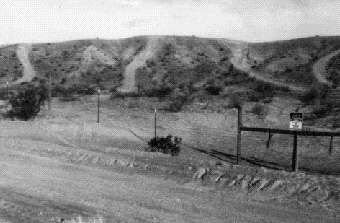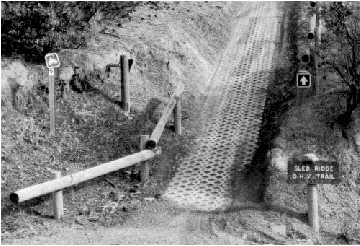



OHV monitoring is casual and damage seldom documented |
Government forestry
and public lands agencies are not giving adequate attention to damage-causing recreational vehicles, a GAO report found last month.
Reviewing eight locations managed by the Forest Service and Bureau of Land Management, investigators found only one-third of employees assigned to oversee use of public lands by Off-Highway Vehicles (OHV) such as motorcycles, 4x4s, and dune buggies were working full time on such assignments. At all locations, OHV monitoring was casual, adverse effects seldom documented, and needed corrective actions were not prioritized. Few citations were issued for violations, in part because the agencies have not done an adequate job of identifying areas that were off-limits. At five locations, no maps existed showing park areas legal for OHV traffic. Signs were not posted frequently or prominently enough to clearly show off-roaders where and under what conditions their vehicles could be used. According to program managers and staff at all locations, these tasks were given a low priority because of limited funding and agency staffing.
|
|---|---|
Few signs exist to show permitted routes or which areas are illegal |
With more acres
of Forest Service land than any state except Alaska,
California ranks first in OHV use in wilderness areas. One area heavily used is the southern Mojave Desert, just over one hour's drive from Los Angeles. During 1993, there were 41 organized events including competitive high-speed racing, sand dune climbing, and cross-country riding.
Although the Bureau of Land Management directed the establishment of a desertwide monitoring program fifteen years ago, it was not established because of constraints on staff resources and the higher priority of other work. Investigators were told the effects of OHV use are primarily identified through incidental, undocumented observations of staff while in the field performing work for other programs. Other damage reports come from the public, including OHV users and environmental groups. Fewer than ten citations were issued in 1993 for resource damage and OHV use in unauthorized areas in the Mojave area. According to law enforcement staff, it is difficult to establish intent when few signs exist to show permitted routes or which areas are illegal. Signs are, however, in place at five areas designated for OHV open-use areas, and at sensitive areas where site-specific plans have been written. |

|
Mentioned as a sensitive site is the Afton
Canyon Natural Area, one of
the few natural riparian areas in the Mojave Desert and habitat for bighorn sheep and birds of prey. Heavily damaged in the 1980's, it was a popular free-play area for motorcycle riders, where racers charged up "Competition Hill." In 1989, the Bureau restricted OHV use
in Afton Canyon and partially fenced it off to prevent further damage. About
$110,000 had been spent through fiscal year 1993 to restore the area.
Although the GAO report notes that last year's California Desert Protection Act transferred 367,000 acres of the Mojave to the National Park Service and closed to OHV use another 707,000 acres designated as wilderness areas, recent events have undone these efforts to protect the region. In late June, Rep. Jerry Lewis diverted all but $1 from the park service budget for the area, leaving the Bureau of Land Management to continue its "multiple-use" management of the desert park.
| |
Lack of enforcement at Upper Lake |
Another region
examined in the report is Upper Lake, used by about 80,000 OHV enthusiasts annually. Investigators found the Upper Lake Ranger District does not systematically monitor OHV use to identify and document adverse effects except for four special motorcycle events that take place each year.
According to Upper Lake staff, an official inventory of OHV roads and trails had not been prepared because of the ranger district's limited resources and other work priorities. The ranger district had, however, developed a map of its roads and trails available for OHV use, and investigators were told that signs had been posted for all of the OHV roads and trails listed on the map. As at all sites, GAO investigators found a lack of enforcement. One damaged site was Streeter Ridge Trail, located within critical habitat for the sensitive Northern Spotted Owl, crosses Bucknell Creek, a tributary to the Eel River and a spawning area for anadromous salmon. Because this section of the trail is extremely steep, attempts by many OHV users to negotiate the 25 to 40 percent grade have caused deep ruts and other damage to the trail and creek. Some corrective actions have been taken on the section of trail that crosses the creek, but the potential for problems still exists. |

|
Sled Ridge Trail had become known as an OHV users' playground, where a growing number of unauthorized trails and other effects of OHV use -- such as erosion and stripped vegetation -- were occurring, particularly around the campground and on Elk Mountain, a sensitive watershed area. As a result of the erosion and subsequent rutting from constant OHV use, staff hardened the surface of the trail through a process called "armoring," installing interlocking concrete bricks.
| |
Reviews in 1979, 1986, and 1991 found the same problems |
Policies
and procedures regulating the use of
off-highway vehicles on federal lands were first issued in the 1970's by Executive Order.
The need for such
action arose from the increased use of motorcycles, all-terrain
vehicles, four-wheel drive vehicles, and other types of OHVs
for recreation. Sometimes, these vehicles damaged
soil, watersheds, vegetation, Native resources, or their use clashed with other forms
of outdoor recreation, such as hiking, picnicking, and horseback
riding.
A 1979 report found both Bureau of Land Management and the Forest Service slow to address damage from OHVs. Similarly, 1986 and 1991 reviews criticized the Bureau and the Forest Service for the same deficiencies found in this year's report, including incomplete mapping, inadequate posting of routes, and limited monitoring of the effects of OHVs. As a result of this year's review, the Forest Service has told the GAO that it will create an action plan to improve the OHV program. |
All Rights Reserved.
Contact rights@monitor.net for permission to reproduce.